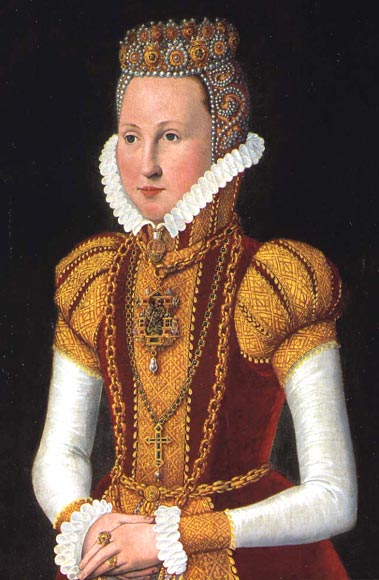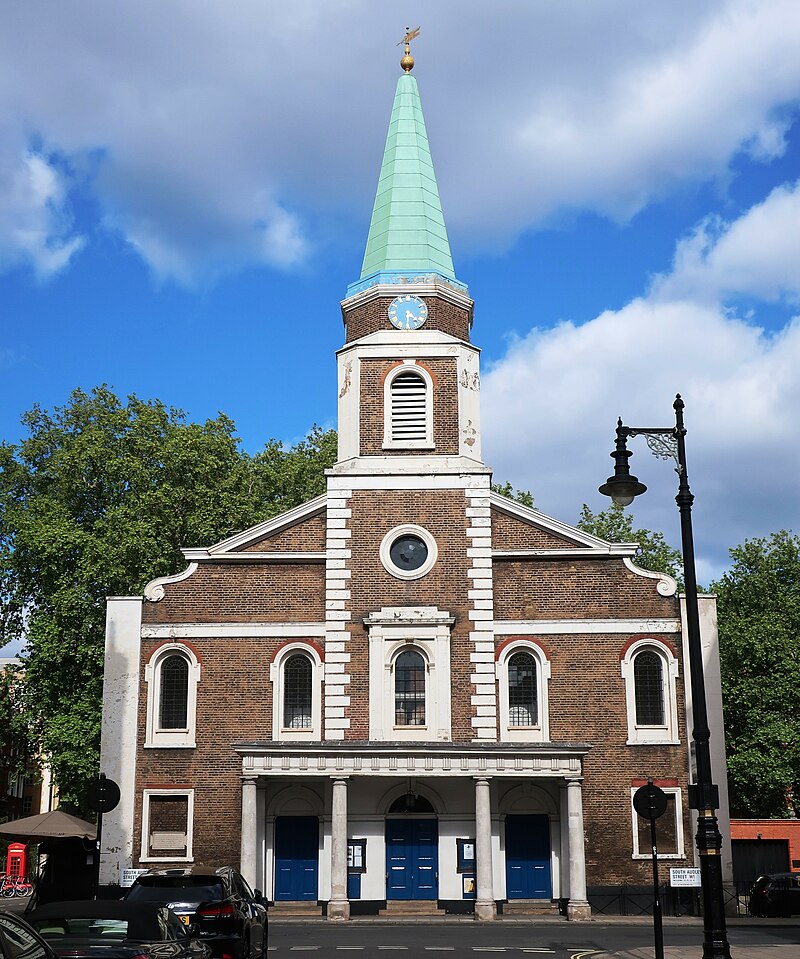© Unofficial Royalty 2024

Sophie of Mecklenburg-Güstrow, Queen of Denmark and Norway; Credit – Wikipedia
September 4, 1199 – Death of Joan of England, daughter of King Henry II of England, wife of King William II of Sicily and Raymond VI, Count of Toulouse, at Fontevrault Abbey near Chinon, in the County of Anjou, now in France; buried at Fontevrault Abbey
Voyages on storm-tossed ships on the Mediterranean Sea. Being held captive and penniless by your husband’s successor and then being gallantly rescued by your brother. Being marooned and nearly captured after a strong storm and again being gallantly rescued by your brother. Accompanying your brother and his new wife, on the Crusades in the Holy Land. Being offered by your gallant brother as a bride to the brother of the man who led the Islamic opposition in the Crusade. Being left to deal with a rebellion while you are pregnant. Sounds like the imagination of an author for a new book, but in reality, it is the life of Joan of England, the youngest daughter of King Henry II of England and Eleanor of Aquitaine. However, Joan does have prominent roles in Sharon Penman’s wonderful novels Devil’s Brood and Lionheart where she is referred to as Joanna.
Unofficial Royalty: Joan of England, Queen of Sicily, Countess of Toulouse
September 4, 1557 – Birth of Sophie of Mecklenburg-Güstrow, Queen of Denmark and Norway, wife of King Frederik II of Denmark and Norway, in Wismar, Duchy of Mecklenburg, now in the German state of Mecklenburg-Vorpommern
In 1572, Sophie married King Frederik II of Denmark and Norway. The couple had seven children. Through their daughter Anna, who married James VI, King of Scots, later also James I, King of England, they are ancestors of the British Royal Family. Despite a 23-year age difference, Frederik II and Sophie had a happy marriage. Sophie is consistently mentioned in Frederik’s handwritten diary as “mynt Soffye“, meaning “my Sophie”. She never interfered in government matters but always accompanied him on his travels, participated in his hunts, and nursed him when he was ill. Sophie was interested in books, visited the Danish pioneering astronomer Tycho Brahe, collected folk songs, and encouraged historian Anders Sørensen Vedel to publish his Hundredvisebogen, a collection of a hundred Danish folk songs he had gathered that became the foundation of Danish literary tradition.
Unofficial Royalty: Sophie of Mecklenburg-Güstrow, Queen of Denmark and Norway
September 4, 1588 – Death of Robert Dudley, 1st Earl of Leicester, favorite of Queen Elizabeth I of England, at Cornbur Park near Oxford, England; buried in the Beauchamp Chapel at the Collegiate Church of St Mary in Warwick, England
In July 1588, as the Spanish Armada came closer to the coast of England, Queen Elizabeth I appointed Robert Lieutenant and Captain-General of the Queen’s Armies and Companies. On August 19, 1588, when Queen Elizabeth I gave her famous Speech to the Troops at Tilbury, a bareheaded Robert walked beside her horse. However, Robert had been in ill health for some time. Modern historians suspect the illness was malaria or stomach cancer. On his way to take the healing baths in Buxton, Derbyshire, England, Robert Dudley, 1st Earl of Leicester, aged 56, died at Cornbury Park near Oxford, England, on September 4, 1588. Elizabeth was extremely upset and locked herself in her rooms for a few days until Lord Burghley ordered the door to be broken down. Six days before Robert’s death, Elizabeth had received a letter from him. She kept the letter, labeled “his last letter” in her bedside treasure box for the rest of her life.
Unofficial Royalty: Robert Dudley, 1st Earl of Leicester, favorite of Queen Elizabeth I of England
September 4, 1729 – Birth of Louis, Dauphin of France, son of King Louis XV of France, at the Palace of Versailles in Versailles, France
Louis, Dauphin of France was the elder son and heir apparent of his father Louis XV, King of France. Unfortunately, like several other Dauphins that preceded him, Louis died prematurely and never became King of France. After the death of his first wife Maria Teresa Rafaela, Infanta of Spain, Louis married Maria Josepha of Saxony. They had eight children including three Kings of France: Louis XVI, Louis XVIII, and Charles X. Louis died of tuberculosis at the Château de Fontainebleau in France on December 20, 1765, at the age of 36.
Unofficial Royalty: Louis, Dauphin of France
September 4, 1729 – Birth of Juliana Maria of Brunswick-Wolfenbüttel, Queen of Denmark, 2nd wife of King Frederik V of Denmark, in Wolfenbüttel, Duchy of Brunswick-Wolfenbüttel, now in Lower Saxony, Germany
In 1752, Juliana Maria married King Frederik V of Denmark six months after the death of his first wife Louisa of Great Britain. The couple had one son. After the death of Frederik V, he was succeeded by his son from his first marriage King Christian VII who had many symptoms of mental illness. Juliana Maria was instrumental in a coup that would bring about the fall of Christian VII’s physician Johann Friedrich Struensee and discredit Christian’s wife Caroline Matilda of Wales who was having an affair with Struensee. Juliana Maria arranged for King Christian VII to sign the arrest warrant of Struensee after she had already made the arrest in the name of the king. Struensee was executed and Caroline Matilda was exiled. After the fall of Struensee, Juliana Maria and her son, Christian VII’s half-brother Hereditary Prince Frederik, took charge of the Council of State. Christian VII was only nominally king from 1772 onward.
Unofficial Royalty: Juliana Maria of Brunswick-Wolfenbüttel, Queen of Denmark
September 4, 1745 – Death of Christian Ernst II, Duke of Saxe-Coburg-Saalfeld at Schloss Saalfeld in Saalfeld, Duchy of Saxe-Coburg-Saalfeld, now in Thuringia, Germany; buried in the ducal crypt at the Johanneskirche in Saalfeld, Duchy of Saxe-Saalfeld, now in Thuringia, Germany
Christian Ernst fell in love with Christiane von Koss, the daughter of Saalfeld forestry master. This relationship displeased both his father and his only surviving half-brother Franz Josias. Eventually, Christian Ernst’s father consented to the marriage, and the couple was married morganatically in 1724. As the elder son, Christian Ernst was his father’s heir but because of his unequal marriage, his half-brother Franz Josias claimed the sole inheritance of the duchy. However, Johann Ernst decided that both his sons should reign jointly, and upon his death in 1729, his will forced the joint reign. From 1735, with the support of the Duke of Saxe-Meiningen, Franz Josias effectively ruled over Coburg in his own right. Christian Ernst died childless and his half-brother Franz Josias, who was fourteen years younger, became the sole Duke of Saxe-Coburg-Saalfeld.
Unofficial Royalty: Christian Ernst II, Duke of Saxe-Coburg-Saalfeld
September 4, 1755 – Birth of Axel von Fersen the Younger, favorite of Marie Antoinette, Queen of France, in Stockholm, Sweden
A member of the Swedish aristocracy, Count Axel von Fersen the Younger served as an aide-de-camp and interpreter to French General Rochambeau during the American Revolutionary War. As tensions began to rise in France, the Swedish King appointed von Fersen as his secret envoy to King Louis XVI and Queen Marie Antoinette, subverting the usual diplomatic channels and providing direct contact between the sovereigns. von Fersen became a close friend and favorite of Queen Marie Antoinette. He returned to Sweden during the French Revolution and became one of the closest advisors to King Gustav IV Adolf, rising to the positions of Earl Marshal and Marshal of the Realm. After Gustav IV was deposed, his childless uncle King Carl XIII became king and adopted a Danish prince to be the Crown Prince of Sweden. The new Crown Prince died from injuries after a fall from his horse. Rumors quickly spread that he had been poisoned by Gustav IV’s supporters, more specifically, at the hands of von Fersen. At the Crown Prince’s funeral procession, von Fersen was attacked and killed by the angry mob who blamed him for the Crown Prince’s death.
Unofficial Royalty: Axel von Fersen the Younger, favorite of Marie Antoinette, Queen of France
September 4, 1759 – Death of Princess Elizabeth Caroline of Wales, at Kew Palace in London, England; buried in the Hanover vault under the central part of the Henry VII Chapel at Westminster Abbey in London, England
Elizabeth Caroline was one of the nine children of Frederick, Prince of Wales, son of King George II of Great Britain, and Princess Augusta of Saxe-Gotha-Altenburg. In 1751, when Elizabeth Caroline was ten-years-old, her father died, leaving a pregnant widow with eight children. Elizabeth Caroline’s thirteen-year-old eldest brother George was now the heir to the throne and was created Prince of Wales by his grandfather King George II. George succeeded his grandfather as King George III. According to Horace Walpole, 4th Earl of Orford, an English writer, art historian, and Whig politician, Elizabeth Caroline was extremely delicate and backward. On September 4, 1759, Princess Elizabeth Caroline, aged 18, had died at Kew Palace in London.
Unofficial Royalty: Princess Elizabeth Caroline of Wales
September 4, 1800 – Birth of Queen Pauline of Württemberg, third wife of King Wilhelm I of Württemberg, born Pauline of Württemberg in Riga, Russian Empire, now in Latvia
Full name: Pauline Therese Luise
In 1820, Pauline became the third wife of her first cousin King Wilhelm I of Württemberg. The couple had three children including Wilhelm I’s successor. The couple seemed happy at first, but within a few years, Wilhelm had returned to his mistresses and the marriage became very strained. While not getting the respect she deserved from her husband, Pauline did receive much respect from the people of Württemberg, both for her devotion to helping the poor and because she had provided an heir to the throne.
Unofficial Royalty: Pauline of Württemberg, Queen of Württemberg
September 4, 1864 – Birth of Princess Elise of Hohenlohe-Langenburg, Princess Reuss of Gera, wife of Heinrich XXVII, 5th and the last reigning Prince Reuss of Gera, in Langenburg, Kingdom of Württemberg, now in Baden-Württemberg, Germany
Elise was christened Elise Victoria Feodora Sophie Adelheid and two of her names reflect that her paternal grandmother was Princess Feodora of Leiningen, the half-sister of Queen Victoria of the United Kingdom. Elise’s two siblings have connections to Queen Victoria’s family through their marriages. In 1884, Elise married Heinrich XXVII, the future 5th Prince Reuss of Gera and the couple had five children. Upon the death of his father in 1913, Elise’s husband became the 5th Prince Reuss of Gera and the Regent of the Principality of Reuss-Greiz. His reign was only five years long. After the German defeat in World War I in 1918, Heinrich XXVII abdicated his position as 5th Prince Reuss of Gera and as Regent abdicated for the disabled Heinrich XXIV, 6th Prince Reuss of Greiz. The new government of Reuss-Gera made an agreement with Heinrich XXVII that granted him some castles and land.
Unofficial Royalty: Princess Elise of Hohenlohe-Langenburg, Princess Reuss of Gera
September 4, 1896 – Birth of Aspasia Manos, Princess of Greece, wife of King Alexander I of Greece, in Athens, Greece
Aspasia was the daughter of Colonel Petros Manos and grew up around the Greek royal family because her father was an aide to King Constantine I of Greece. Aspasia and Prince Alexander, the second son of King Constantine I, began a romance, despite the unlikelihood of being able to marry due to their different ranks. In June 1917, King Constantine I was forced to step down from the throne, and his son Alexander was appointed to replace him. Despite the challenges from his family and the Prime Minister, Aspasia and Alexander married secretly on November 17, 1919. Aspasia was not given the title of Queen, instead, she was known simply as Madame Manos. Less than a year later, King Alexander died after contracting septicemia from a monkey bite several weeks earlier. Aspasia was four months pregnant at the time and gave birth to their daughter Alexandra in 1921. Alexander’s father was restored to the throne and issued a decree recognizing the marriage of Alexander and Aspasia and legitimizing their daughter Alexandra. Aspasia was now Princess Alexander of Greece and Denmark. Despite this, her relationship with her husband’s family was never easy.
Unofficial Royalty: Aspasia Manos, Princess of Greece
This article is the intellectual property of Unofficial Royalty and is NOT TO BE COPIED, EDITED, OR POSTED IN ANY FORM ON ANOTHER WEBSITE under any circumstances. It is permissible to use a link that directs to Unofficial Royalty.









